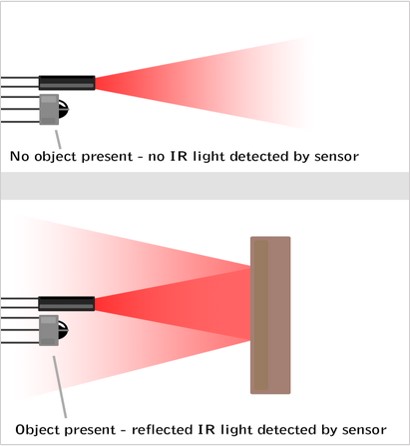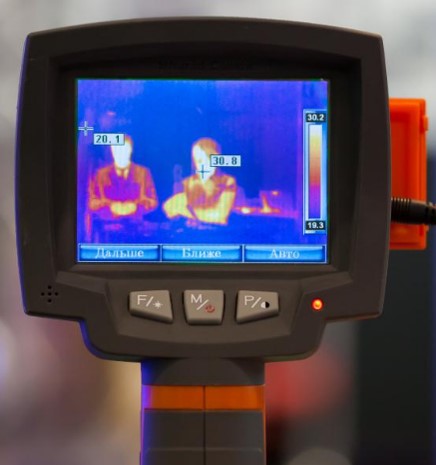An infrared sensor is an electronic instrument which is used to sense certain characteristics of its surroundings by either emitting and/or detecting infrared radiation. Infrared sensors are also capable of measuring the heat being emitted by an object and detecting motion. Many of these types of sensors only measure infrared radiation, rather than emitting it, and thus are known as passive infrared (PIR) sensors.
IR Sensors work by using a specific light sensor to detect a select light wavelength in the Infra-Red (IR) spectrum. By using an LED which produces light at the same wavelength as what the sensor is looking for, you can look at the intensity of the received light. When an object is close to the sensor, the light from the LED bounces off the object and into the light sensor. This results in a large jump in the intensity, which we already know can be detected using a threshold.

Applications
The use of infrared sensors to accurately measure the chemical composition of materials or gases in military applications is well known. Now, however, given their rapidly declining price tag, these IR sensors are gaining traction in Internet of Things M2M applications, including medical diagnostics, imaging and industrial process controls, fire detection and remote gas leak detection, pollution monitoring, and real-time combustion control.
Some of the most important tools for maintaining a clean, safe, and healthy environment are sensors, sensor systems, and sensor networks that detect the presence and quantify the amount of specific chemical trace gases. Once the source is located, monitoring also provided by sensors supports mitigation and compliances.
This is also true for industrial processes and automotive monitoring and health, especially in breath analysis. Today’s standard expensive and time-consuming medical tests will give way to breathalyzers able to diagnose medical conditions on the spot. Medical care will become more proactive and remote care more accurate for today’s aging population.
Infrared vision has several applications. It can visualize heat leaks in houses, help doctors monitor blood flow, identify environmental chemicals in the environment, allow art historians to see under layers of paint, and integrate it with contact lenses or wearable electronics.

Infrared Camera
For optical communication, a modulated IR light beam transmitted by an emitter LED is received by a silicon photodiode. Infrared Data Association standards provide the basis for IR communication. IR technology is the most commonly used technique for remotely controlling appliances, an important aspect of its use in IoT and in connected-home applications.
Conclusion
The use of infrared sensors to accurately measure the chemical composition of materials or gases in military applications is well known. Now, however, given their rapidly declining price tag, these IR sensors are gaining traction in Internet of Things M2M (Machine to Machine) applications, including medical diagnostics, imaging and industrial process controls, fire detection and remote gas leak detection, pollution monitoring, and real-time combustion control.
>>>>> <<<<<
LEAVE A COMMENT below
Your opinion and feedback are important to me

Excellent article. Very useful information. Thank you